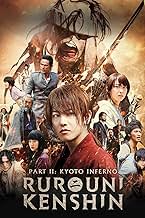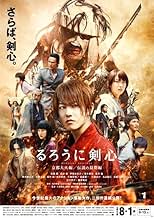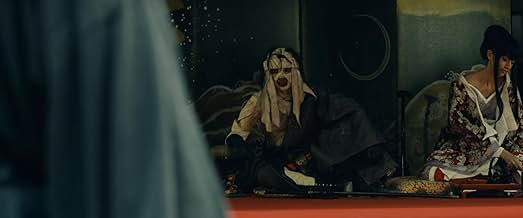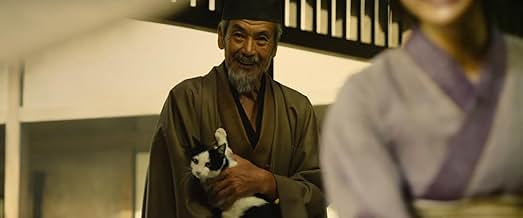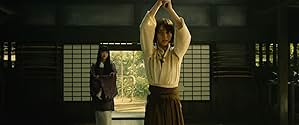IMDb RATING
7.5/10
19K
YOUR RATING
Kenshin Himura goes up against pure evil Makoto Shishio who is attempting to overthrow the Meiji government. The fate of the country hangs in the balance as Kenshin Himura takes up the sword... Read allKenshin Himura goes up against pure evil Makoto Shishio who is attempting to overthrow the Meiji government. The fate of the country hangs in the balance as Kenshin Himura takes up the sword that he vowed to never draw again.Kenshin Himura goes up against pure evil Makoto Shishio who is attempting to overthrow the Meiji government. The fate of the country hangs in the balance as Kenshin Himura takes up the sword that he vowed to never draw again.
- Awards
- 1 win total
Takeru Satoh
- Kenshin Himura
- (as Takeru Satô)
Featured reviews
Based on the hugely popular 1994 manga/anime historical fiction romantic action drama series, Kyoto Inferno is the second instalment of the Rurouni Kenshin (also known as Samurai X in many western countries) trilogy, which tells the story of Himura Kenshin/Battosai, a retired samurai who seeks redemption for his past killings as an assassin to topple the Shogunate government and restore power to the emperor. However, his past soon comes back to haunt him. The sequel picks up where the original left off and the story continued with the Kyoto Arc adaptation, the series' best story arc. This time, stakes are higher as Japan is facing a larger threat imposed by Kenshin's evil successor, Makoto Shishio and Kenshin struggles to stop this impending threat to the newly established Meiji government he helped to restore. Finally, fans get to see their beloved characters brought to life on the big screen again.
As the first of the manga/anime adaptation's two-part finale (Kyoto Inferno - Part 1 and The Legend Ends - Part 2), Shishio, a samurai with formidable skills equivalent to Kenshin's, declared an all-out war against the new government and he intends to bring back the old days of the Shogunate - "survival of the fittest" where the strong shall live and the weak shall die. He is joined by his the Juppongatana (Ten Swords), a group of highly skilled, elite assassins and a huge army of warriors under his command to destroy everything that stands in his way. On the other hand, Kenshin is joined by many new allies, The Oniwabanshu (Hidden Watcher ninjas), a surviving remnant of the old Shogunate's spy network in Kyoto and Saito Hajime, the current chief of police of the Meiji government who was the former Shinsengumi head (military police protecting the Shogunate).
The film benefits from the strong performances from the lead characters. Takeru Sato did a great job portraying as the reluctant and conflicted hero Kenshin, who's unwillingness to kill is constantly challenged by his desire to protect the innocent at the same time. The same could be said for Tatsuya Fujiwara as the main antagonist Shishio, who managed to create a frightful and imposing presence every time he appears on screen. The goals for the characters were clear from the beginning of the film. Yosuke Eguchi and Ryunosuke Kamiki both stand out as the icy cool chief of police Hajime Saito and cheerful young assassin Soujiro Seta (who's also one of the Juppongatana members) respectively. However, I was quite particularly annoyed by Munetaka Aoki's over-the-top performance as Sanosuke. His character was not well-handled and there was a lot of forced acting and unnecessary movements whenever he appears on screen.
Despite the numerous deviations from the source material (especially with the origin of the Oniwabanshu leader Aoshi), there's a lot attention to detail went into this movie. The character designs used for the film were as close to the source material as it could possibly be. A lot of the important manga/anime plot scenes were recreated with some minor changes to keep the core of the story intact. Moreover, what's really surprising is that the details of etiquette and mannerism of samurai or ninja was taken quite seriously in the film, which makes it feels like a Japanese period piece.
The film is filled with intensely well-choreographed, well-filmed sword-fighting scenes. Many of the action scenes were tightly choreographed and the fast paced sword fights were performed with some rather inventive moves. The depiction of the various legendary kenjutsu Hiten Mitsurugi-ryu (Flying Heaven Govern Sword-Style) techniques such as Ryutsuisen (Dragon Hammer Flash), Ryushosen (Dragon Flight Flash), Ryusosen (Dragon Nest Flash) look realistic enough on screen. The fight scene as Kenshin swiftly takes down Shishio's army from all directions in a village was truly a sight to behold. Moreover, the fight between the Oniwabanshu ninja leaders Aoshi (Captain) and Okina (Elder) makes for a great action sequence as well.
As an adaptation, it is understood that it is necessary to pay homage to many of the well-known characters in the series for the fans. This results in a lot of characters are introduced in this sequel and some of them are less developed due to the limited screen time. Although the film did well in showing Kenshin's past struggles and Shishio's dark past, the subplot of the Oniwabanshu members, especially Misao and Aoshi doesn't fit in nicely to the story. Aoshi's motivations for searching and killing Battosai was unconvincing and feels downright flat. The presence of the Juppongatana (Ten Swords) was weak as other members hardly get any screen time at all (except Soujiro Seta and Cho of course). Hopefully we'll be able to see more of these characters in The Legend Ends, the last film in the trilogy.
Overall, Kyoto Inferno sets the pieces for the final epic showdown between Shishio with his Juppongatana and Kenshin with his allies. A lot of things are being pushed off for The Legend Ends and doesn't actually conclude by the end of this film, so it's rather difficult to judge this film on its own. We'll just have to wait and see.
Rating: 7/10
http://yjcool.blogspot.com/2014/11/movie-review-rurouni-kenshin- kyoto.html
As the first of the manga/anime adaptation's two-part finale (Kyoto Inferno - Part 1 and The Legend Ends - Part 2), Shishio, a samurai with formidable skills equivalent to Kenshin's, declared an all-out war against the new government and he intends to bring back the old days of the Shogunate - "survival of the fittest" where the strong shall live and the weak shall die. He is joined by his the Juppongatana (Ten Swords), a group of highly skilled, elite assassins and a huge army of warriors under his command to destroy everything that stands in his way. On the other hand, Kenshin is joined by many new allies, The Oniwabanshu (Hidden Watcher ninjas), a surviving remnant of the old Shogunate's spy network in Kyoto and Saito Hajime, the current chief of police of the Meiji government who was the former Shinsengumi head (military police protecting the Shogunate).
The film benefits from the strong performances from the lead characters. Takeru Sato did a great job portraying as the reluctant and conflicted hero Kenshin, who's unwillingness to kill is constantly challenged by his desire to protect the innocent at the same time. The same could be said for Tatsuya Fujiwara as the main antagonist Shishio, who managed to create a frightful and imposing presence every time he appears on screen. The goals for the characters were clear from the beginning of the film. Yosuke Eguchi and Ryunosuke Kamiki both stand out as the icy cool chief of police Hajime Saito and cheerful young assassin Soujiro Seta (who's also one of the Juppongatana members) respectively. However, I was quite particularly annoyed by Munetaka Aoki's over-the-top performance as Sanosuke. His character was not well-handled and there was a lot of forced acting and unnecessary movements whenever he appears on screen.
Despite the numerous deviations from the source material (especially with the origin of the Oniwabanshu leader Aoshi), there's a lot attention to detail went into this movie. The character designs used for the film were as close to the source material as it could possibly be. A lot of the important manga/anime plot scenes were recreated with some minor changes to keep the core of the story intact. Moreover, what's really surprising is that the details of etiquette and mannerism of samurai or ninja was taken quite seriously in the film, which makes it feels like a Japanese period piece.
The film is filled with intensely well-choreographed, well-filmed sword-fighting scenes. Many of the action scenes were tightly choreographed and the fast paced sword fights were performed with some rather inventive moves. The depiction of the various legendary kenjutsu Hiten Mitsurugi-ryu (Flying Heaven Govern Sword-Style) techniques such as Ryutsuisen (Dragon Hammer Flash), Ryushosen (Dragon Flight Flash), Ryusosen (Dragon Nest Flash) look realistic enough on screen. The fight scene as Kenshin swiftly takes down Shishio's army from all directions in a village was truly a sight to behold. Moreover, the fight between the Oniwabanshu ninja leaders Aoshi (Captain) and Okina (Elder) makes for a great action sequence as well.
As an adaptation, it is understood that it is necessary to pay homage to many of the well-known characters in the series for the fans. This results in a lot of characters are introduced in this sequel and some of them are less developed due to the limited screen time. Although the film did well in showing Kenshin's past struggles and Shishio's dark past, the subplot of the Oniwabanshu members, especially Misao and Aoshi doesn't fit in nicely to the story. Aoshi's motivations for searching and killing Battosai was unconvincing and feels downright flat. The presence of the Juppongatana (Ten Swords) was weak as other members hardly get any screen time at all (except Soujiro Seta and Cho of course). Hopefully we'll be able to see more of these characters in The Legend Ends, the last film in the trilogy.
Overall, Kyoto Inferno sets the pieces for the final epic showdown between Shishio with his Juppongatana and Kenshin with his allies. A lot of things are being pushed off for The Legend Ends and doesn't actually conclude by the end of this film, so it's rather difficult to judge this film on its own. We'll just have to wait and see.
Rating: 7/10
http://yjcool.blogspot.com/2014/11/movie-review-rurouni-kenshin- kyoto.html
One of those rare sequels that only improves upon the promises of it's predecessor, a dynamic and sprawling adaptation of the franchises infamous Kyoto arc. THIS, and the previous film should be held in high regard, and be looked to as the gold standard of how to adapt a long running arc to film format. This film seriously trims all of the needless filler character fat from the source. What they changed turned out to be good for it. Incredible action direction once again coordinated by Kenji Tanigaki. The devotion from the actors here, as they all performed their own stunts and mastered their own choreography, is really a feat to behold. All in all, Kyoto Inferno is just as good as the first film, if not better. Despite being the first of a two part sequel, it manages to be a self-sufficient, coherent story. Virtuosic.
I am deeply surprised. I was expecting a really bad adaptation, as it has been done before. This movie however is great. If you grew up watching the anime you will be pleased, as it brings to life the right personality of the characters. They even have that goofiness Himura always showed whenever he was surrounded by the ones he loved. But shifting right back to some cold heart determined killer that awarded him his nickname. The fighting scenes, were tremendous. None of that "shaking camera" BS that Hollywood vomits on us. Really well done.
The filming and editing are sublime. I could easily notice on one of the big fights (wont spoil it for you), the still burning ashes floating around the scene, giving me instant flashbacks to the anime. Really nice touch. And the opening scene of Shishio and Saito is tremendous.
The action is great. Himura is perfectly portrayed, with all of his goofy nuances, deep honor, shame, guilt, and killer instinct. And the same can be said of the remaining characters. Sanosuke is as obnoxious and lovable as ever. And Sojiro is perfectly depicted in his psychopath childish assassin persona.
I feel like i could show this movie to people that have never seen the anime, and they would still love it. Great work guys.
The filming and editing are sublime. I could easily notice on one of the big fights (wont spoil it for you), the still burning ashes floating around the scene, giving me instant flashbacks to the anime. Really nice touch. And the opening scene of Shishio and Saito is tremendous.
The action is great. Himura is perfectly portrayed, with all of his goofy nuances, deep honor, shame, guilt, and killer instinct. And the same can be said of the remaining characters. Sanosuke is as obnoxious and lovable as ever. And Sojiro is perfectly depicted in his psychopath childish assassin persona.
I feel like i could show this movie to people that have never seen the anime, and they would still love it. Great work guys.
Are you Japanese Live-Action Fan?
If Yes, No reason to miss this show. This is the best live-action movie I've ever watched!
The Storyline: Great The Action Scene: Excellent (You will not see the awesome samurai fight like this!) The Music or Soundtrack: More than excellent!
and with the length that more than 2 hours, you will really enjoy the show. NO REASON TO MISS, Believe ME!
If No, then It's depend on you. Japanese Movie Style may boring for someone who never watched.
However, Let's give a chance for this one.
If Yes, No reason to miss this show. This is the best live-action movie I've ever watched!
The Storyline: Great The Action Scene: Excellent (You will not see the awesome samurai fight like this!) The Music or Soundtrack: More than excellent!
and with the length that more than 2 hours, you will really enjoy the show. NO REASON TO MISS, Believe ME!
If No, then It's depend on you. Japanese Movie Style may boring for someone who never watched.
However, Let's give a chance for this one.
The Chief of Police Hajime Saito (Yôsuke Eguchi) and a team of policemen hunt down the outlaw Makoto Shishio (Tatsuya Fujiwara), who was betrayed by the government after defeating the Tokugawa shogunate; however Shishio and his men slaughter the police officers and only Hajime survives. Kenshin Himura (Takeru Satô) is summoned by the government to help them to find Shishio in Kyoto. He refuses first, but when a minister is murdered, he accepts to go and leaves the dojo of Kaoru Kamiya (Emi Takei) and the boy Yahiko Myojin (Kaito Ohyagi), his friend Sanosuke Sagara (Munetaka Aoki) and Dr. Megumi Takani (Yû Aoi). Kenshin meets the thief Makimachi Misao (Tao Tsuchiya) that tries to steal his sakabato on the way to Kyoto and they stumble upon a boy that tells that his brother and his parents are in danger. They find the trio murdered by Shishio's men and Kenshin defeats them in the nearby village. A man called Sojiro Seta (Ryûnosuke Kamiki) contacts Kenshin and brings him to meet Shishio that asks Sojiro to duel Kenshin. Their sword fight stops when Kenshin's sakabato is broken and Shishio and his men go away. Meanwhile, Kaoru decides to find Kenshin in Kyoto and Yahiko and Sanosuke follow her. When Kenshin arrives at Kyoto, Misao asks whether he would like to go to a cheap inn. Kashiwazaki Nenji (Min Tanaka), who was the ninja Okina that worked for the Tokugawa shogunate, runs the place and teams up with Kenshin. He seeks out the talented blacksmith Shakku Arai to repair his sakabato and finds that he is dead. Arai's son Keiku does not help Kenshin, but when the evil Sawagejo Cho (Ryosuke Miura) kidnaps his baby, he calls Kenshin to save his son and gives him a new sakabato. Kenshin defeats the Shishio's warrior and he is arrested by the police. Soon Hajime and Kenshin learn that Shishio intends to burn Kyoto down and they prepare the defense of the town. Is Sawagejo Cho telling the truth?
"Rurôni Kenshin: Kyôto taika-hen", a.k.a. "Rurouni Kenshin: Kyoto Inferno", is a spectacular sequel of "Rurôni Kenshin: Meiji kenkaku roman tan". The story follows Kenshin and his friends from the first film and introduces a villain more evil than in the first film. The sad moment is the unknown fate of the gorgeous and sweet Kaoru Kamiya. Every viewer and fan is certainly hoping she has survived. My vote is ten.
Title (Brazil): "Samurai X 2: O Inferno de Kyoto" (Samurai X 2: The Kyoto Inferno")
"Rurôni Kenshin: Kyôto taika-hen", a.k.a. "Rurouni Kenshin: Kyoto Inferno", is a spectacular sequel of "Rurôni Kenshin: Meiji kenkaku roman tan". The story follows Kenshin and his friends from the first film and introduces a villain more evil than in the first film. The sad moment is the unknown fate of the gorgeous and sweet Kaoru Kamiya. Every viewer and fan is certainly hoping she has survived. My vote is ten.
Title (Brazil): "Samurai X 2: O Inferno de Kyoto" (Samurai X 2: The Kyoto Inferno")
Did you know
- TriviaOkubo Toshimichi was a real historical figure who lived from 1830 to 1878. He was killed by a group of disgruntled samurai while he was in a carriage going back to his Tokyo home. The attack did happen on May14th.
- GoofsWhen Kenshin rides out to save Kaoru, he makes it to Shishio's ship in one night. Kyoto is an inland city. The sea is almost 50 km away in Osaka. Yet, the movie makes it seem like he reaches the sea in mere minutes.
- Quotes
Kenshin Himura: The dead wish only that the living be happy.
- ConnectionsFeatured in Mundo ni Juan sa Japan (2015)
- SoundtracksMighty Long Fall
Written by Takahiro Moriuchi (as Taka) and John Feldmann
Performed by One Ok Rock
Courtesy of A-Sketch
- How long is Rurouni Kenshin Part II: Kyoto Inferno?Powered by Alexa
Details
- Release date
- Country of origin
- Official site
- Language
- Also known as
- Rurouni Kenshin Part II: Kyoto Inferno
- Production companies
- See more company credits at IMDbPro
Box office
- Gross worldwide
- $52,696,176
- Runtime2 hours 18 minutes
- Color
- Sound mix
- Aspect ratio
- 2.35 : 1
Contribute to this page
Suggest an edit or add missing content



